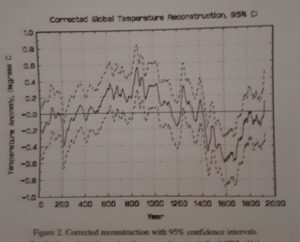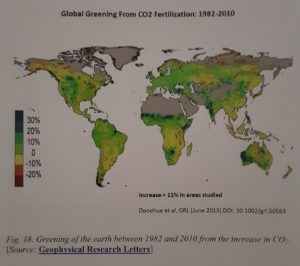
There are so many voices screaming at us everyday it seems. Doomsday Prophets, Conservationists, Evolutionists, Climate Change Advocates, Climate Change Deniers, Astrophysicists, NASA, Democrats, Republicans, The Pope, Holistic Doctors, Vaccine Producers, Philanthropists, Business Stakeholders, all manner of Organizations, all manner of religious groups, Abortion advocates, Right to Life advocates, Homosexuals, Feminists, News Media, etc. etc. etc.
Who should we believe? What should we believe? They all point to their numbers and information sources to justify their point of view. They all claim to KNOW what is coming and how to fix it. Or at least they claim they are trying to fix it…But, what is really behind their claims and what is their motivation?
I learned at a young age that numbers can be manipulated and statistics were invented to be used to promote and support whatever view you intend.
.
The Western forest economy has been hit with two sawmill closures in Montana, and as a reason for closure, management cited an inability to find labor, exacerbated by high costs of living in the area. This is a surprise to know one familiar with rural economics, and it foreshadows a much larger and more widespread problem, but new opportunities arise. CORRECTION: I said a few times that the “birth rate” problem is worse in rural areas. I should have said the “population problem,” as in many cases, the problem is the kids leaving the area after high school. There is also a larger problem with the “labor force participation rate” due to a higher prevalence of drug use in some rural areas. Also, as some have mentioned, it is technically incorrect to say China’s economy is bigger than the US in “absolute” terms because the figure I refer to is the GDP PPP, which adjusts GDP figures for currency purchasing power. By “absolute” I just mean to say “not per capita.” Join my newsletter and get your free DIY forest management guide: https://thetimberlandinvestor.com/how… 0:00 – Sawmill Closures 3:03 – Demography Overview 5:20 – Consequences of Older Populations 9:20 – The Industrialization of Mexico 12:25 – Immigration 17:55 – Birthrates 21:00 Why It Matters for Forestry 22:52 – “Artificial Intelligence” 25:50 – The Future
END OF UPDATE
spacer
The simple truth about statistics
In the age of the internet, there is no reason why anyone should be fooled by statistics
Matt Parker’s website is Stand-up Mathematician
It is the British prime minister Benjamin Disraeli who is famously credited with the phrase: “There are three kinds of lies: lies, damned lies, and statistics” but the expression has been around almost as long as the word statistics (first coined in 1749 for those wondering). What is it about numerical data that sparks such distrust in people?
Partly, there seems to be an assumption that anything involving numbers is an dark art that needs to be left to experts. Few non-mathematicians – including politicians and journalists – seem to have the numerical confidence to question or check statistics they are given. This led the (then opposition) Conservative party to report in February this year that in deprived areas 54% of women under 18 will fall pregnant (it should have been 5.4%). Then the Independent continued the theme last week (22 September) by deciding that 49% of all girls under 18 have had abortions. If you make the quick assumption that half of all under 18s are under 9s, then this implies all girls from 9 to 18 must have had an abortion. In both of these cases, if people had taken the time to think about the statistics, any logical person could tell that something was amiss.
spacer
Lies, Damned Lies, and Statistics
spacer
Misleading Statistics Examples – Discover The Potential For Misuse of Statistics & Data In The Digital Age

Statistical analyses have historically been a stalwart of the high-tech and advanced business industries, and today they are more important than ever. With the rise of advanced technology and globalized operations, statistical analyses grant businesses insight into solving the extreme uncertainties of the market.
As businesses are often forced to follow a difficult-to-interpret market roadmap, statistical methods can help with the planning that is necessary to navigate a landscape filled with potholes, pitfalls, and hostile competition. Statistical studies can also assist in the marketing of goods or services, and in understanding each target market’s unique value drivers. In the digital age, these capabilities are only further enhanced and harnessed through the implementation of advanced technology and business intelligence software. If all this is true, what is the problem with statistics?
Statistics are infamous for their ability and potential to exist as misleading and bad data.
What Is A Misleading Statistic?
Misleading statistics refers to the misuse of numerical data either intentionally or by error. The results provide deceiving information that creates false narratives around a topic. Misuse of statistics often happens in advertisements, politics, news, media, and others.
Given the importance of data in today’s rapidly evolving digital world, it is important to be familiar with the basics of misleading statistics and oversight. As an exercise in due diligence, we will review some of the most common forms of misuse of statistics, and various alarming (and sadly, common) misleading statistics examples from public life.
Are Statistics Reliable?
73.6% of statistics are false. Really? No, of course, it’s a made-up number (even though such a study would be interesting to know – but again, could have all the flaws it tries at the same time to point out). Statistical reliability is crucial in order to ensure the precision and validity of the analysis. To make sure the reliability is high, there are various techniques to perform – the first of them being the control tests, which should have similar results when reproducing an experiment in similar conditions. These controlling measures are essential and should be part of any experiment or survey – unfortunately, that isn’t always the case.
While numbers don’t lie, they can in fact be used to mislead with half-truths. This is known as the “misuse of statistics.” It is often assumed that the misuse of statistics is limited to those individuals or companies seeking to gain profit from distorting the truth, be it economics, education, or mass media.
However, the telling of half-truths through study is not only limited to mathematical amateurs. A 2009 investigative survey by Dr. Daniele Fanelli from The University of Edinburgh found that 33.7% of scientists surveyed admitted to questionable research practices, including modifying results to improve outcomes, subjective data interpretation, withholding analytical details, and dropping observations because of gut feelings…. Scientists!
While numbers don’t always have to be fabricated or misleading, it is clear that even society’s most trusted numerical gatekeepers are not immune to the carelessness and bias that can arise with statistical interpretation processes. There are different ways in which statistics can be misleading that we will detail later. The most common one is of course correlation versus causation, which always leaves out another (or two or three) factors that are the actual causation of the problem. Drinking tea increases diabetes by 50%, and baldness raises the cardiovascular disease risk up to 70%! Did we forget to mention the amount of sugar put in the tea or the fact that baldness and old age are related – just like cardiovascular disease risks and old age?
So, can statistics be manipulated? They sure can. Do numbers lie? You can be the judge.
Misleading Statistics Examples In Real Life
Now that we’ve put the misuse of statistics in context, let’s look at various digital age examples of statistics that are misleading across five distinct, but related, spectrums: media and politics, news, advertising, science, and healthcare. While certain topics listed here are likely to stir emotion depending on one’s point of view, their inclusion is for data demonstration purposes only.
1) Examples of misleading statistics in politics

Misleading statistics in politics are quite common. On Sept. 29, 2015, Republicans from the U.S. Congress questioned Cecile Richards, the president of Planned Parenthood, regarding the misappropriation of $500 million in annual federal funding. The above graph/chart was presented as a point of emphasis.
Representative Jason Chaffetz of Utah explained: “In pink, that’s the reduction in the breast exams, and the red is the increase in the abortions. That’s what’s going on in your organization.”
Based on the structure of the chart, it does in fact appear to show that the number of abortions since 2006 experienced substantial growth, while the number of cancer screenings substantially decreased. The intent is to convey a shift in focus from cancer screenings to abortion. The chart points appear to indicate that 327,000 abortions are greater in inherent value than 935,573 cancer screenings. Yet, closer examination will reveal that the chart has no defined y-axis. This means that there is no definable justification for the placement of the visible measurement lines.
Politifact, a fact-checking advocacy website, reviewed Rep. Chaffetz’s numbers via a comparison with Planned Parenthood’s own annual reports. Using a clearly defined scale, here is what the information looks like:

And like this with another valid scale:
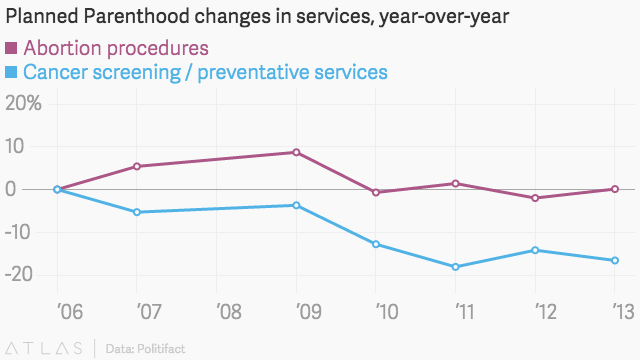
Once placed within a clearly defined scale, it becomes evident that while the amount of cancer screenings has in fact decreased, it still far outnumbers the amount of abortion procedures performed yearly. As such, this is a great misleading statistics example, and some could argue bias considering that the chart originated not from the Congressman, but from Americans United for Life, an anti-abortion group. This is just one of many examples of misleading statistics in the media and politics.
2) Examples of misleading statistics in healthcare
Just like other industries or areas that we will cover on this list of examples, the healthcare industry is not free of the misuse of statistics. Although this controversy happened around 1996, the case of Purdue Pharma and their highly addictive drug OxyContin is still affecting thousands of American citizens and has already taken the lives of thousands of others to this date, all due to the misuse of statistics as a marketing tactic.
The case started when the giant pharmaceutical company, Purdue Pharma, launched its new product OxyContin, which they advertised as a safe, non-addictive opioid that was highly effective for pain relief. Once hearing this statement, doctors were skeptical, as they knew how dangerously addictive opioids could be to treat chronicle pain.
Amongst various videos of “success cases” of patients, merchandising, and unethical messaging included in Purdue’s marketing strategy to advertise OxyContin as a safe drug, there was a very interesting graph, used to prove to doctors that the drug was non-addictive because it stayed on the patient’s blood over time avoiding symptoms of withdrawal. The problem was, the graph, which is depicted below, was built with a y-axis on a logarithmic scale instead of a linear one, making it look like the rate of change is smaller than it actually is.

It was this unethical and misleading graph, which was also FDA approved, that helped in initiating one of the biggest health crises in the US, opioid addiction. Although in 2007 the company was forced to pay a $600 million fine for its criminal actions, the consequences of this are still seen to date. This a sad representation of how dangerous misinformation can be.
3) Misleading COVID statistics
This list of misleading statistics fallacy examples would not be complete without referencing the COVID-19 pandemic. During the initial stages of COVID, the general public was forced to consume scientific information in the form of data visualizations to stay informed about the current developments of the virus. But this didn’t come easy. The lack of statistical literacy from the public, paired with the fact that organizations didn’t always share accurate statistical information, lead to widespread misrepresentation of data.
Christopher Engledowl & Travis Weiland wrote an insightful article called “Data (Mis)representation and COVID-19: Leveraging Misleading Data Visualizations For Developing Statistical Literacy Across Grades 6–16”. There, they speak about two use cases in which COVID-19 information was used in a misleading way. Let’s look at one of them closely.
In May 2020, around 5 months after COVID-19 started spreading around the world, the US Georgia Department of Public Health posted a chart that aimed at showing the top 5 counties that had the highest COVID-19 cases in the past 15 days and the number of cases over time.
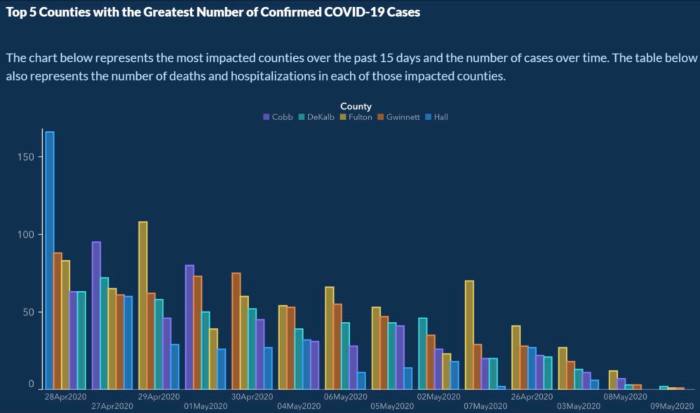
Source: Vox
Now, if we take a closer look at this chart we can find a few mistakes that make the information very misleading. First of all, the X-axis does not have a label, even though according to the chart, it is meant to show the number of cases over time, this doesn’t happen.
Another issue, and maybe the worst of them all, is that the dates under the bars are not ordered chronologically. Instead, we see the dates between April and May interspersed with the aim of making viewers of this graph believe that the cases are gradually decreasing. This is paired with the fact that counties are not always depicted in the same order, but instead in descending order of cases. This is with the same aim of making it seem like the cases are dropping.
The graph generated a big controversy on social media, especially on Twitter, where users pointed out that the Georgia Health Department had repeatedly used misleading statistics during the COVID-19 outbreak. As an answer to the issue, Candice Broce, the communications director for Giorgia’s Governor. Brian Kemp’s said: “The x-axis was set up that way to show descending values to more easily demonstrate peak values and counties on those dates, our mission failed. We apologize. It is fixed”. The graph was later republished with organized dates and counties. You can see the updated version below.
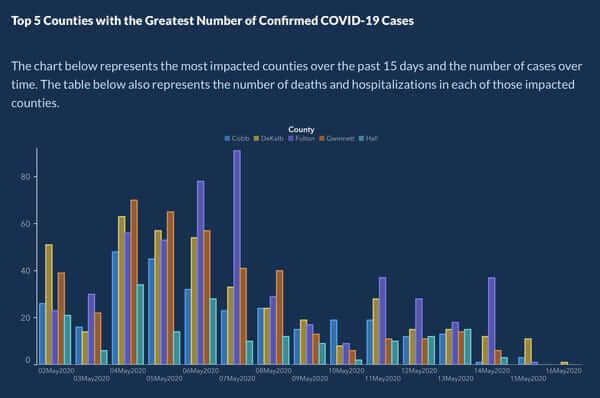
Source: Business Insider
This is one of the many controversial examples of misleading COVID statistics that illustrates the authorities’ responsibility to inform their audience accurately. In critical scenarios such as a global pandemic, this becomes even more important as misinformation can lead to a higher spread and more deaths. To avoid situations like this, there is a bunch of healthcare analytics software that assists analysts and average users in the creation of stunning and accurate visualizations for their data.
4) Misleading statistics in advertising

Next, in our list of bad statistics examples, we have the case of a popular toothpaste brand. In 2007, Colgate was ordered by the Advertising Standards Authority (ASA) of the U.K. to abandon their claim: “More than 80% of Dentists recommend Colgate.” The slogan in question was positioned on an advertising billboard in the U.K. and was deemed to be in breach of U.K. advertising rules.
The claim, which was based on surveys of dentists and hygienists carried out by the manufacturer, was found to be misrepresentative as it allowed the participants to select one or more toothpaste brands. The ASA stated that the claim “… would be understood by readers to mean that 80 percent of dentists recommend Colgate over and above other brands, and the remaining 20 percent would recommend different brands.”
The ASA continued, “Because we understood that another competitor’s brand was recommended almost as much as the Colgate brand by the dentists surveyed, we concluded that the claim misleadingly implied 80 percent of dentists recommend Colgate toothpaste in preference to all other brands.” The ASA also claimed that the scripts used for the survey informed the participants that the study was being performed by an independent research company, which was inherently false.
Based on the misuse techniques we covered, it is safe to say that this sleight off-hand technique by Colgate is a clear example of misleading statistics in advertising, and would fall under faulty polling and outright bias.
5) Misleading statistics examples in the news
Misuse of statistics is present everywhere and news outlets are no exception. American network Fox News has been under scrutiny several times throughout the years for showing misleading statistics graphs that seem to purposely portray a conclusion that is not accurate. The most recent case happened not too long ago in September 2021. During one of Fow New’s broadcasts, anchor Tucker Carlson displayed a graph saying that the number of Americans identifying as Christians had collapsed over the last decade.

Source: www.rawstory.com
In the image above, we can see a graph showing 77% of Christian Americans in 2009, a number that decreased to 65% in 2019. Now, if the issue here is not obvious enough, we can see that the Y-axis in this chart starts from 58% and ends at 78%, making the 12% drop from 2009 to 2019 look way more significant than it actually is.
As mentioned, this is not the only time Fox News has been criticized because of these situations. Examples of misuse of statistics in the media are very common. Columbia Journalism School professor Bill Grueskin even made a lesson to its students about the topic and used several misleading charts from the US news show as an example of what not to do when presenting data. Grueskin shared some of these insightful examples of misleading statistics in the news in a Twitter thread that became very popular. We took a very obvious one to show you below.
For the presidential run of 2012, the news network showed the graph below where we see a pie chart displaying a total of 193% which is clearly wrong and misleading as the total should be 100%.

Source: Bill Grueskin
6) Misleading statistics in the media
Television is not the only media platform that can provide examples of bad statistics in the news. In 2006, The Times, a popular UK newspaper, printed a story about how they were the leading paper both online and in print in the UK. The article, titled “The Times leaves the rest behind” started by displaying a graphic of the exponential growth of The Times website visitors from 2004 to 2006. Which saw an increase of millions of visitors in just a couple of years, so far, everything looks normal.
The issue comes with the second graph that is displayed in the article, in which we see a comparison of full-price sales between The Times and one of its biggest competitors, the Daily Telegraph. At a glance, the chart makes you believe that The Times has twice as many full-price subscriptions as its competitor. However, a closer look shows that the X-axis starts at 420,000 instead of 0. Making the difference between the two publications a lot bigger than what it actually is, which is just 10%.
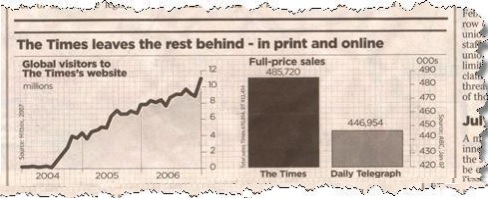
Source: statisticshowto.com
Now, you might argue that The Times is telling the truth, as they are actually leading over their competitors. Regardless, many people will look at the graph and get a different idea of what the actual difference is, which is an unethical and dangerous practice. Just like we saw with Fox News examples, the manipulation of the axes can completely change the way the information on a graph is perceived. We will discuss this specific case in more detail later in the post.
7) Misleading statistics in science
Much like abortion, global warming (aka Climate Change) is another politically charged topic that is likely to arouse emotions. It also happens to be a topic that is vigorously endorsed by both opponents and proponents via studies. Let’s take a look at some of the evidence for and against.
It is generally agreed upon that the global mean temperature in 1998 was 58.3 degrees Fahrenheit. This is according to NASA’s Goddard Institute for Space Studies. In 2012, the global mean temperature was measured at 58.2 degrees. It is, therefore, argued by global warming opponents that, as there was a 0.1-degree decrease in the global mean temperature over a 14-year period, global warming is disproved.
The below graph is the one most often referenced to disprove global warming. It demonstrates the change in air temperature (Celsius) from 1998 to 2012.
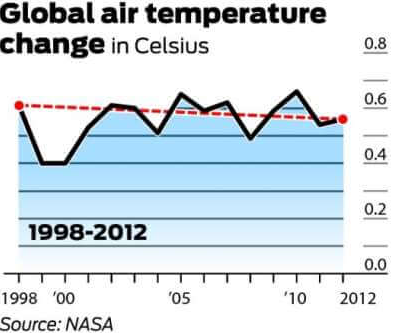
It is worth mentioning that 1998 was one of the hottest years on record due to an abnormally strong El Niño wind current. It is also worth noting that, as there is a large degree of variability within the climate system, temperatures are typically measured with at least a 30-year cycle. The below chart expresses the 30-year change in global mean temperatures.
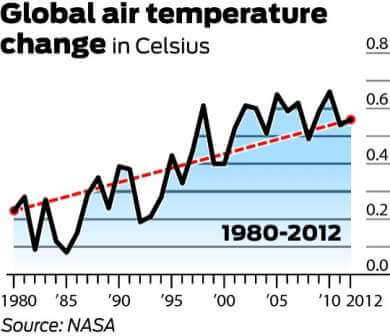
And now have a look at the trend from 1900 to 2012:
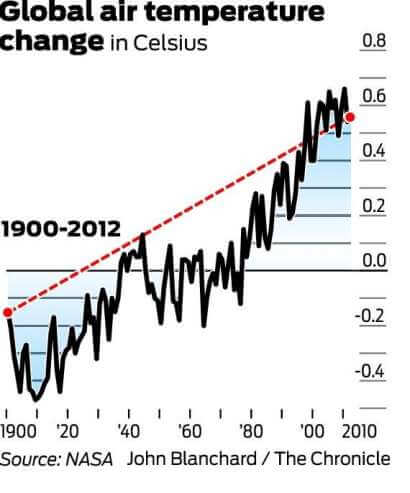
While the long-term data may appear to reflect a plateau, it clearly paints a picture of gradual warming. Therefore, using the first graph, and only the first graph, to disprove global warming is a perfect misleading statistics example.
spacer
940K subscribers
President Trump is right to withdraw from the Paris Climate Agreement! The deal isn’t worth the paper it is written on. ——– Don’t miss a single video from Stossel TV, sign up here: https://johnstossel.activehosted.com/f/1 ——— But many politicians and much of the media are horrified. Al Gore called pulling out of the Paris Agreement a “reckless and indefensible decision.” Former President Obama said: “This administration joins a handful of nations that reject the future.” Really? Have they read the agreement? Stossel interviewed one of the few people who did, City Journal Contributing Writer Oren Cass. He describes the agreement as “somewhere between a farce and a fraud.” Why so dismissive? Because, as Cass told Stossel, “you don’t even have to mention greenhouse gases in your commitment. You send in any piece of paper you want, we’re going to staple them all together and we’re going to call that the Paris Accord.” What is in these commitments (or not in them) will surprise you. China pledged to “achieve the peaking of carbon dioxide emissions around 2030.” That sounds good, except a U.S. government study, done before the Paris Agreement, estimated China would reach peak emissions by 2030. So China pledged to continue doing exactly what it was doing. Yet Cass told Stossel China was one of the better pledges. “India made no pledge to limit their emissions at all. They pledged only to become more efficient…But they proposed to become efficient less quickly than they’re already becoming more efficient. So their pledge was to slow down.” Pakistan’s pledge was even more meaningless, simply pledge to reak a peak emission “much beyond the year 2030.” Cass says only one country took a different approach, the U.S., which set the goal of reducing greenhouse gas emissions by 26% to 28% below 2005 levels, by 2025. “President Obama took all the zero commitments from everybody else, but threw in a really expensive one for us.” Oren Cass and John Stossel don’t dispute basic climate science. Stossel says yes, the earth is warming. Man may well be increasing that. But the solution isn’t to waste billions by forcing emissions cuts in America while other countries do nothing– while pretending to make cuts. Trump was right to repudiate this phony treaty. Most of us didn’t even know how phony it was. But now we do.
spacer
939K subscribers
——– Don’t miss a single video from Stossel TV, sign up here: https://johnstossel.activehosted.com/f/1
spacer
Though they were fully aware that our climate was heating up, they were selling us on the idea that we were headed for an ICE AGE. By their own admission as you will see below, earth goes through natural cycles of heating and cooling and has throughout history.
Climate and the environment is an area where they love to lie with statistics. FEAR is a great motivator and nothing is scarier than weather you cannot control. They want to keep people feeling helpless and in need of “science” to save them. One minute it is GLOBAL COOLING/ICE AGE, the next it is GLOBAL WARMING/Flooding. Now they just call it Climate Change so that no matter what they are doing with the weather…we scared and helpless.
Global cooling – Wikipedia
|
In 1975, Newsweek Predicted A New Ice Age. We’re Still … Longreads
https://longreads.com › 2017/04/13 › in-1975-newswee…
Apr 13, 2017 — In 1975, Newsweek Predicted A New Ice Age. We’re Still Living with the Consequences
|
| Climate change
United Nations
Climate change refers to long-term shifts in temperatures and weather patterns. Human activities have been the main driver of climate change, primarily due to the burning of fossil fuels like coal, oil and gas.
513 subscribers 135,301 views Mar 1, 2013 “Climate experts believe the next ice age is on its way.” – Leonard Nimoy, 1978 |
|
March 24, 2021
Updated March 24, 2021
The climate is getting warmer and weirder. So let’s turn the wayback machine to January 1998. That’s when The Atlantic, known then as The Atlantic Monthly, published a cover story called “The Great Climate Flip-Flop” by William H. Calvin, a theoretical neurophysiologist based at the University of Washington in Seattle. “Of this much we’re sure: Global climate flip-flops have frequently happened in the past, and they’re likely to happen again,” Calvin’s article is filled with frightening details, including evidence that natural global warming in millenia past triggered ice ages in exactly the same way he was warning us about. |
spacer
8) Misleading crime statistics
Rather its politicians trying to make a point for their own interest or just someone not understanding the information behind the graphs and charts they create, crime statistics are not free of being misleading. A controversial representation of this happened in 2014 when a graph depicting the number of murders committed using firearms in Florida from 1990 to 2010 was published in the context of the “Stand Your Ground” law, enacted in 2005 to give people the right to use deadly force for self-defense.
At a first glance, the graph, which is displayed below, shows a descending trend that starts the year the law was enacted, concluding that “Stand Your Grown” is responsible for the apparent drop in the number of murders committed using firearms in the years after it was implemented. However, when taking a closer look at the graph, we can see that the y-axis is reversed, starting with the highest numbers at the bottom and reaching 0 at the top.

Source: livescience.com
Taking that into account, what the graph is actually showing is an increase in deaths using firearms after the law was enacted. Now, as we learned throughout this post, we can’t say with certainty that the law caused the rise in deaths as there are other factors that could influence that number. There is also no evidence to say that the Florida Law Enforcement Department was purposely deceiving the public. However, at the time this graph was published, many media publications interpreted the graph as if the deaths dropped, showing how damaging the misuse of graphs and numbers can be.
How Can Statistics Be Misleading

Remember, misuse of statistics can be accidental or purposeful. While a malicious intent to blur lines with misleading statistics will surely magnify bias, the intent is not necessary to create misunderstandings. The misuse of statistics is a much broader problem that now permeates multiple industries and fields of study. Here are a few potential mishaps that commonly lead to misuse:
1) Faulty polling
The manner in which questions are phrased can have a huge impact on the way an audience answers them. Specific wording patterns have a persuasive effect and induce respondents to answer in a predictable manner.
2) Flawed correlations
The problem with correlations is this: if you measure enough variables, eventually it will appear that some of them correlate. As one out of twenty will inevitably be deemed significant without any direct correlation, studies can be manipulated (with enough data) to prove a correlation that does not exist or that is not significant enough to prove causation.
3) Data fishing
This misleading data example is also referred to as “data dredging” (and related to flawed correlations). It is a data mining technique where extremely large volumes of data are analyzed for the purpose of discovering relationships between different points. Seeking a relationship between data isn’t a misuse per se, however, doing so without a hypothesis is.
Likewise, another common practice with data is omission, meaning that after looking at a large data set of answers, you only pick the ones that are supporting your views and findings and leave out those that contradict them. As mentioned at the beginning of this article, it has been shown that a third of the scientists admitted that they had questionable research practices, including withholding analytical details and modifying results…! But then again, we are facing a study that could itself fall into this 33% of questionable practices, faulty polling, and selective bias… It becomes hard to believe any analysis!
4) Misleading data visualization
Insightful graphs and charts include a very basic, but essential, grouping of elements. Whatever the types of graphs and charts you choose to use, it must convey:
5) Purposeful and selective bias
The next of our most common examples for misuse of statistics and misleading data is, perhaps, the most serious. Purposeful bias is the deliberate attempt to influence findings without even feigning professional accountability. Bias is most likely to take the form of data omissions or adjustments to prove a specific point.
The selective bias is slightly more discreet for those who do not read the small lines. It usually falls down on the sample of people surveyed. For instance, the nature of the group of people surveyed: asking a class of college students about the legal drinking age, or a group of retired people about the elderly care system. You will end up with a statistical error called “selective bias”. To avoid this issue, you should always pick a random sample of people whose background may or may not be related to the topic of the survey.
6) Percentage change in combination with a small sample size
Another way of creating misleading statistics, also linked with the choice of sample discussed above, is the size of said sample. When an experiment or a survey is led on a totally not significant sample size, not only will the results be unusable, but the way of presenting them – namely as percentages – will be totally misleading.
7) Truncating an axis
Truncating an axis is another way in which statistics can be misleading. When creating a graph to portray a statistic, it is natural to assume that the X and Y axes start at zero. Truncating axes means doing the opposite. For example, starting the axes in a predefined value so that it will affect the way the graph is perceived to achieve a certain conclusion. This technique is often used in politics to exaggerate a result that would otherwise be much less interesting.
8) Strategically picking the time period
Another common misuse of statistics is strategically picking the time period to show a result. This is a case of misleading statistics that can be done purposely, to achieve a specific result, or accidentally. For example, picking only a good-performing month to build a sales report will portray a misleading picture of the overall sales performance.
Purposely or not, the time periods we choose to portray will affect the way viewers perceive the data. For instance, showing a value for 3 months can show radically different trends than showing it over a year.
9) Simpson’s Paradox
According to a definition by the Stanford Encyclopedia of Philosophy, a Simpson’s Paradox is a statistical phenomenon where “an association between two variables in a population emerges, disappears or reverses when the population is divided into subpopulations”. Now, you might be wondering, how can this be misleading?
Well, a Simpson’s Paradox can happen when an analyst doesn’t look at the complete scope of the data. When this paradox goes unnoticed, it can significantly influence the way the data is interpreted, leaving room to believe a certain conclusion or assumption is an absolute truth, when it could change by looking at it from a different perspective.
spacer
Now that we have seen how numbers are easily manipulated and employed to manipulate us… let’ take a look at some factors you may have not seen or considered.
We have been bombarded by fearmongers screaming that the world is overpopulated and if we don’t eliminate a large portion of the population disaster will strike. But, is that really the case? Is the Earth OVERPOPULATED? OR, could it be… that the World’s population is really in such a decline that we will soon become extinct?
spacer
Why Japan’s Population Is Still Declining – Japanese interview
↓ Japanese online course with Go Go Nihon https://japaneseonline.gogonihon.com/…
spacer
650K subscribers
Compare news coverage. Spot media bias. Avoid algorithms. Try Ground News today and get 30% off your subscription by going to https://ground.news/tldr South Korea’s record-low birth rates signal a fertility crisis with implications for depopulation and national security. Despite longstanding government efforts, the situation persists, offering insights into broader fertility challenges.
spacer
575K subscribers
Sign up for a 14-day free trial and enjoy all the amazing features MyHeritage has to offer https://bit.ly/WilliamSpaniel By the Kremlin’s own assessment, Russia faces a looming demographics crisis. Reverberations from World War II deaths and economic turbulence in the 1990s have left too many pensioners and too few young workers. This demographics problem have caused major protests in Russia before, and the domestic political conversation today still continues in its shadow. Some even speculate it is the root behind the invasion of Ukraine. This video discusses the origins of the looming crisis, how the Kremlin has tried to mitigate the corresponding problems, and what issues still remain on the horizon. 0:00 Russia’s Population Problem 4:16 Demographics and World War II 6:55 Fertility Rate and the Fall of the Soviet Union 9:03 Collapsing Demographics and Russia’s Pension Plan 14:02 Demographics and the Invasion of Ukraine 18:15 How the War Will Cause Further Demographics Problems Media licensed under KOGL Type 1 Attribution: By Blue House: https://www.kogl.or.kr/edu/eduDataFil…
spacer
Sign up for FREE Geopolitics Newsletter: https://www.globalrecaps.com/subscribe
799K subscribers
Go to https://hensonshaving.com/TLDR and enter “TLDR” at checkout to get 100 free blades with your purchase. With Donald Tusk sworn in as Prime Minister once again, he’s set his sights on tackling Poland’s appallingly low fertility rate and their ongoing demographic crisis. So in this video, we discuss the mess they’re in and whether it can actually be fixed.
398K subscribers
Due to financial constraints, young people in China are hesitant to date, marry, or have children. The previously eager Chinese population regarding childbearing has suddenly become one of the least interested groups. Over a mere decade, from 2013 to 2023, China’s population has halved, with its birth rate plummeting to the lowest globally. #chinaobserver All rights reserved.
More cracks are emerging in the path to recovery for China’s economy, as it logs one of its slowest growth rates in more than three decades. Asia’s largest economy also saw another year of population decline, despite government efforts to boost a flagging birth rate and stave off a demographic crisis. Low Minmin reports from Shanghai. Subscribe to our channel here: https://cna.asia/youtubesub
History’s greatest sidekicks plans for independence have hit a wall.
Get a lifetime subscription to Nebula here: https://go.nebula.tv/tldrnewseu Watch the Daily Discussions: https://nebula.tv/thedailybriefing While global fertility is dropping, provisional data for 2023 suggests that Europe’s is falling at an unprecedented rate. In this video, we’ll explore the existing crisis, why it’s getting worse and whether European governments can do anything to fix it.
spacer

d3sign/Moment RF/Getty Images
A new study projects that global fertility rates, which have been declining in all countries since 1950, will continue to plummet through the end of the century, resulting in a profound demographic shift.
The fertility rate is the average number of children born to a woman in her lifetime. Globally, that number has gone from 4.84 in 1950 to 2.23 in 2021 and will continue to drop to 1.59 by 2100, according to the new analysis, which was based on the Global Burden of Diseases, Injuries, and Risk Factors Study 2021, a research effort led by the Institute for Health Metrics and Evaluation (IHME) at the University of Washington. The study was published Wednesday in the journal the Lancet.
“What we are experiencing now, and have been experiencing for decades, is something that we have not seen before in human history, which is a large-scale, cross-national, cross-cultural shift towards preferring and having smaller families,” said Dr. Jennifer D. Sciubba, a demographer and author of “8 Billion and Counting: How Sex, Death, and Migration Shape Our World,” who was not involved with the new research.
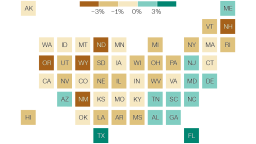
RELATED ARTICLEFertility rates dip, people are having babies later: The state of birth rates in the US
Dr. Christopher Murray, senior author of the study and director of IHME, said there are many reasons for this shift, including increased opportunities for women in education and employment and better access to contraception and reproductive health services.
(Not to mention the rise in homosexuality, the lack of interest in marriage on both sides, the poor economic situation that makes it totally impossible to afford children or to provide for them, the scary world we live in where we are threatened with extinction from every direction and made to feel guilty for taking up space and resources.)
Dr. Gitau Mburu, a scientist in the World Health Organization’s Department of Sexual and Reproductive Health and Research who wrote a comment that was published alongside the study, said in an email to CNN that economic factors such as the direct cost of raising children, the perceived risk of death to children and changing values on gender equality and self-fulfillment are all forces that may contribute to declining fertility rates. The relative contribution of these factors varies over time and by country, he added.
(JUST) To maintain stable population numbers, countries need a total fertility rate of 2.1 children per woman, a number called the replacement level. When the fertility rate falls below the replacement level, populations begin to shrink.
The new analysis estimates that 46% of countries had a fertility rate below replacement level in 2021. That number will increase to 97% by 2100, meaning the population of almost all countries in the world will be declining by the end of the century. (Oh, I doubt it will take that long, but notice how they throw these numbers around with nothing to support them or information on the basis for them)
A previous analysis by IHME published in the Lancet in 2020 predicted that the world population will peak in 2064 at around 9.7 billion and then decline to 8.8 billion by 2100. Another projection by the UN World Population Prospects 2022 predicted world population to peak at 10.4 billion in the 2080s.
Regardless of the exact timing of peak world population, it will likely begin declining in the second half of the century, (wait, what? It is already declining, how can it begin again?) Sciubba said, with dramatic geopolitical, economic and societal consequences.
‘Demographically divided world’
Although fertility rates are declining in all countries, the rate of decline is uneven, creating a shift in the distribution of live births around the globe, according to the analysis.
The study predicts that the share of the world’s live births in low-income regions will nearly double from 18% in 2021 to 35% in 2100. Sub-Saharan Africa alone will account for 1 in every 2 children born on the planet by 2100.
“An important contribution of the study is to highlight the demographic contrast between the richest countries (with very low fertility) and the poorest countries (with still high fertility),” Dr. Teresa Castro Martín, a professor at the Institute of Economics, Geography and Demography of the Spanish National Research Council, who was not involved with the new research, said in a statement from the Science Media Centre. “Globally, births will be increasingly concentrated in the areas of the world most vulnerable to climate change, resource scarcity, political instability, poverty and infant mortality.”
spacer
Is the World’s Demographic Crisis Getting Worse?
653K subscribers
Sign up to Brilliant (the first 200 sign ups get 20% off an annual premium subscription): https://brilliant.org/tldrglobal/ The world population continues to grow and shows no signs of stopping for at least a few more decades. But despite this, there has been a worrying trend of falling birth rates and shrinking populations worldwide, and countries such as China and Japan are already experiencing significant declines. In this video, we analyse the trends behind the decline, delve into potential solutions, and their implications for the future.
spacer
The World Population Crisis NO ONE Sees Coming
658K subscribers
Population Collapse: If you’re struggling, consider therapy with our sponsor BetterHelp. Click https://betterhelp.com/twobitdavinci for a 10% discount on your first month of therapy with a licensed professional specific to your needs. We have all lived in a world where populations have been exploding, and for good reason. Between advancements in technology and engineering, we’ve gotten really good at sustaining human life on our precious planet. But we’re living in unprecedented times, and we might be looking at the height of human population before a collapse. In my research for this video, I uncovered some startling data, and we need to talk about this. Let’s figure this out together!
spacer
Charted: The Rapid Decline of Global Birth Rates
Published
10 months ago on By Pablo Alvarez
Article/Editing: Pallavi Rao
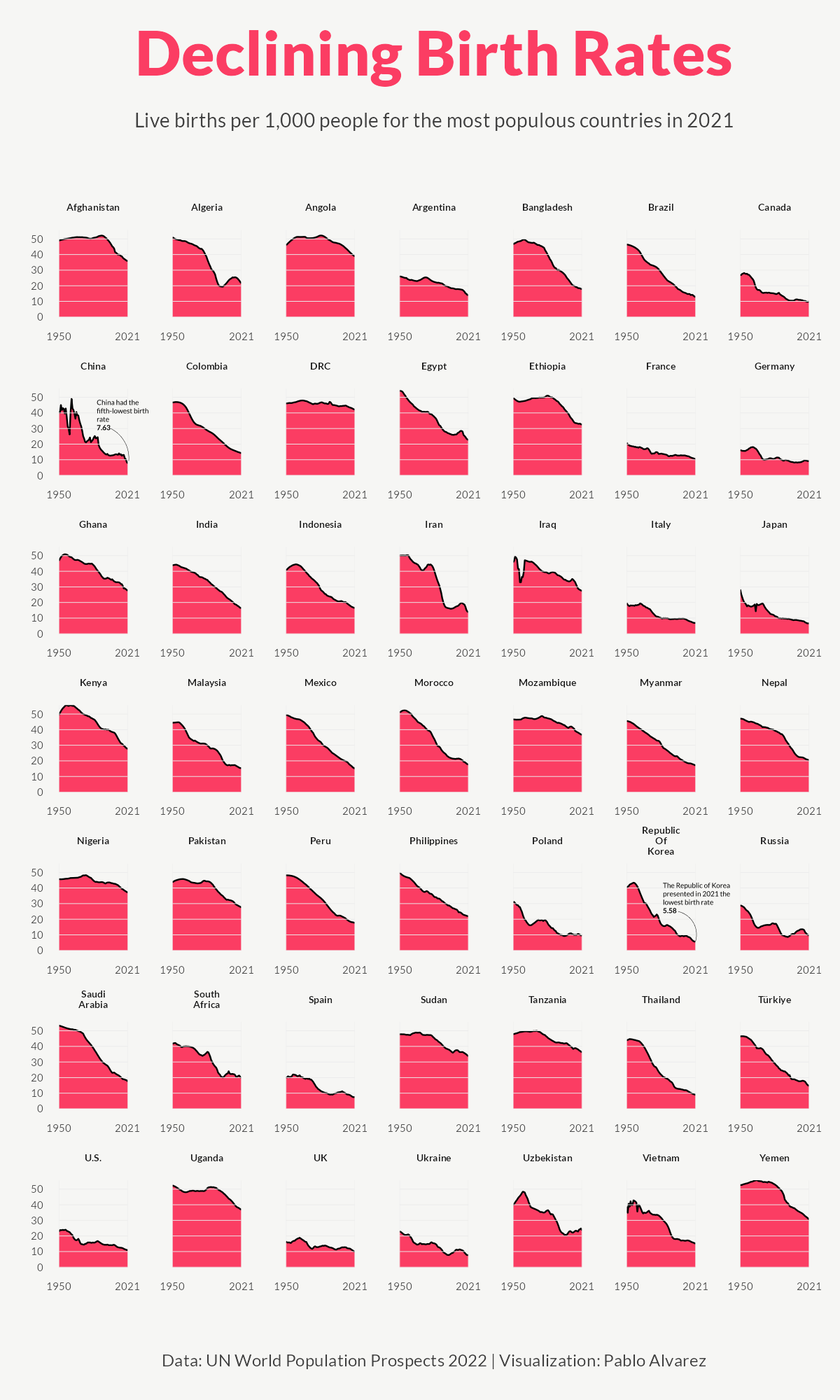
In 1798, British economist Thomas Malthus proposed a groundbreaking theory now known as the “Malthusian Trap”—suggesting that human population growth is exponential and thus would outpace the linear growth of resources such as food supply.
He worried that this runaway population growth would become unsustainable, eventually relying on sudden shock events—wars, disasters, famines—to reset the population to more sustainable levels. And over the next 200 years, the world population skyrocketed from 1 billion to 8 billion people on the planet.
However, as it turns out, no such shock events were required to turn the tide of population growth. Instead, it’s been rapidly declining birth rates across the world that seem to be leading to an unthinkable outcome for Malthus: a gradually plateauing or even shrinking global population.
In the visualization above, Pablo Alvarez has visualized the crude birth rate for the 49 most populous countries of the world in 2021, using data from the UN’s World Population Prospects 2022 to examine changes since 1950.
Understanding Birth Rates vs Fertility Rates
Birth rates are commonly measured using a metric called the “crude birth rate” (CBR), which represents the number of live births per 1,000 individuals in a given population during a specific period—usually one year.
The measured decline in CBR is also a result of plummeting fertility rates across the globe. Not to be confused with birth rates, fertility rates measure how many children a woman will have over the course of her lifetime. (Of course there are many factors that affect fertility, the junk in the water we drink and the air we breath, the accumulation of hormones in the water, the soy and tofu in our food products, the vaccines and the genetically modified fruits and vegetables, the insecticides we are exposed to, and lack of fresh air and exercise we get.)
Birth Rates of the Most Populated Countries
Here’s a snapshot of the CBR (Crude Birth Rate) for the 49 most populous countries of the world at different years from 1950 to 2021.
| Country | 1950 | 1990 | 2021 | % Change (1950-2021) |
|---|---|---|---|---|
| 🇦🇫 Afghanistan | 48.87 | 51.42 | 35.84 | -27% |
| 🇩🇿 Algeria | 51.05 | 30.76 | 21.52 | -58% |
| 🇦🇴 Angola | 46.15 | 51.34 | 38.81 | -16% |
| 🇦🇷 Argentina | 26.00 | 21.99 | 13.90 | -47% |
| 🇧🇩 Bangladesh | 46.52 | 34.97 | 17.82 | -62% |
| 🇧🇷 Brazil | 46.43 | 24.84 | 12.88 | -72% |
| 🇨🇦 Canada | 26.80 | 15.46 | 9.82 | -63% |
| 🇨🇳 China | 41.05 | 24.44 | 7.63 | -81% |
| 🇨🇴 Colombia | 46.74 | 27.37 | 14.20 | -70% |
| 🇨🇩 DRC | 46.02 | 46.01 | 42.05 | -9% |
Every country on the list has seen a decline in birth rates in the last 70 years, with some declines more staggering than others. For example, China recorded 41 births per 1,000 people in 1950. By 2021, that number had fallen to just 7.6, a 81% decrease.
South Korea, the 29th most populous country in the world in 2021, saw an even larger 86% drop in its birth rate since 1950. In fact, almost every single country in this dataset has seen a double-digit fall in their birth rates over the past 70 years. Only the Democratic Republic of Congo has seen a single-digit percentage decline between 1950 and 2021.
Why are Global Birth Rates Falling?
For the 49 most populated countries in 2021, birth rates have halved on average in the last 70 years:
| 49 Most Populated Countries | 1950 | 1990 | 2021 |
|---|---|---|---|
| Average Birth Rate | 40.99 | 30.18 | 19.50 |
| Median Birth Rate | 45.73 | 30.76 | 17.10 |
But while the thought of a shrinking world population may seem worrisome, declining birth rates are generally thought of as a triumph of rapid socio-economic development.
Growing urbanization is another key driver of declining birth rates, characterized by smaller living spaces, increased focus on careers, and limited support networks. Another is the growing access to family planning services and contraceptives, particularly since the 1970s.
What are the Future Consequences?
The biggest consequence of declining birth rates—and one that is already being seen in many parts of the world—is a rapidly aging population.
Declining birth rates can also impact the labor market and economic productivity. A smaller workforce may lead to labor shortages, skill gaps, and reduced innovation. And shrinking populations reduce consumer demand, a cornerstone of the global economy, which may trigger a restructure of the current growth model of development.
spacer
Infertility rates and population decline are skyrocketing, and it’s not just about couples choosing not to have kids. The real story is that our current lifestyles are wielding a mighty influence in this alarming decline, and the same factors that influence overall health impact fertility.
Today on The Dhru Purohit Podcast, Dhru sits down with Ronit Menashe and Vida Delrahim, co-founders of WeNatal, to unveil the staggering crisis of plummeting populations and fertility rates. Ronit and Vida share the critical role of environmental toxins and metabolic dysfunction in causing low fertility. They also break down the research on infertility and population decline and dish out the keys to unlocking fertility including quality sleep, diet, movement, and stress reduction.
Ronit Menashe and Vida Delrahim are the co-founders of WeNatal, a prenatal supplement company intentionally designed for women and men. Ronit and Vida are also advocates for couples and individuals who aren’t aware of how the modern world and the toxic environment that we all live in could be impacting our fertility journeys.
In this episode, Dhru, Ronit, and Vida dive into:-The shocking rates of population decline and low fertility rates-Lower sperm levels in men-The role of environmental toxins on fertility-Infertility in women and increased rates of miscarriages-The one percent effect -Reproductive health as a sign of overall health -Ronit and Vida’s personal story -The role of IVF -The three main root causes of infertility -Concluding thoughts on fertility and why WeNatal -Ronit and Vida’s mission
spacer
What is Abortion Really About?
DIY ABORTION TRAGIC NEW DEVELOPMENTS
Dark Forces in the USA
RU 486 – DIY Abortion
Satan’s Con
SATANISTS DECLARE ABORTION A RELIGIOUS RITUAL
IT’s OFFICIAL!! THE USA has turned to BAAL Child Sacrifice
spacer
A question one might ask is where does abortion fit in the picture? What do we really know about abortion rates? What are the statistics based on? And what about babies and children who are killed in other ways and for other reasons? How do they affect the population crisis?
Once more exposing a return of eugenics, Democrat lawmakers are beginning to rationalize their protection of abortion by stating that killing babies is cheaper than taking of them, especially when they’re disabled.
— Ways To Support My Work —

Source: FatNews Bitchute channel – Originally titled: Sudden Infant Death Syndrome (SIDS) is caused by vaccines, notes Paul Thomas, MD – First published at 21:12 UTC on February 19th, 2023.
“Almost all of the SIDS (Sudden Infant Death Syndrome) — 97% or 98% — happens the week AFTER a vaccine,” Paul Thomas, MD tells Steve Kirsch. “SIDS (Sudden Infant Death Syndrome) is NOT happening a week BEFORE a vaccine.” “Now we have Sudden Adult Death Syndrome (SADS) [ people dropping dead suddenly and unexpectedly from the COVID-19 vaccines ].”
1 year, 2 months ago

“Religious liberty and the separation of religion and state must be protected and preserved to maintain our democratic society.” – Eileen Filler-Corn
Reality Rants with Jason Bermas 8AM EST Mon-Thur
I’m Fired Up with Chad Caton 10AM EST Mon and Wed
Foreign and Domestic 11AM EST Saturday
JD Rucker 2PM EST – Mon-Fri
Drew Berquist 4PM EST Mon-Thur
RVM Roundup 6PM EST Mon-Thur

1 year, 2 months ago
What the Covid Vaccination is Doing to Women: Injuries, Killing Babies, Murder!
The Jewish Covid Manufacturers are Deliberately Murdering People!
Genocide! Military Whistleblowers on Miscarriages and Infertility Rates increase after Covid Shots
CDC (Centers for Disease Control) Data: Over 4,000 Miscarriages (Murders) in Vaers from Covid-19 Vaccines / The Baby Genocide the Jewish Vaccine Makers and Jewish MSM Don’t Want you to know about!
Dr. Ryan Cole dropped a nuclear truth bomb on Covid-19 Jab, Bill Gates, Fauci and Eric Rubin
* * * * * * * * * * * * * * * * * * * * *
1 year, 3 months ago
spacer

Michelle Gershman (RN) is speaking out! It’s shocking!!!
1 year, 3 months ago
spacer
Supreme Court to decide if Biden can punish hospitals that fail to provide abortions in Emergencies
spacer

U.S. KILLING BABIES (Abortion) is Necessary for Military Readiness – Biden National Security Spokesman John Kirby
9 months, 1 week ago
spacer
Global abortion rates by region 1990-2019
spacer
Worldwide, an estimated 25 million unsafe abortions occur …
spacer
More than 42 million global abortions in 2020
Abortion Surveillance—Findings and Reports
Abortion Surveillance 2021
In 2021, 625,978 legal induced abortions were reported to CDC from 48 reporting areas. Among 47 reporting areas with data each year during 2012–2021, in 2021, a total of 622,108 abortions were reported, the abortion rate was 11.6 abortions per 1,000 women aged 15–44 years, and the abortion ratio was 204 abortions per 1,000 live births.
From 2020 to 2021, the number of abortions increased 5%, the abortion rate increased 5%, and the abortion ratio increased 4%. From 2012 to 2021, the number, rate, and ratio of reported abortions decreased 8%, 11%, and 1%, respectively.
Similar to previous years, in 2021, women in their twenties accounted for more than half of abortions (57.0%). Nearly all abortions in 2021 took place early in gestation: 93.5% of abortions were performed at ≤13 weeks’ gestation; a smaller number of abortions (5.7%) were performed at 14–20 weeks’ gestation, and even fewer (0.9%) were performed at ≥21 weeks’ gestation. Early medication abortion is defined as the administration of medication(s) to induce an abortion at ≤9 completed weeks’ gestation, consistent with the current Food and Drug Administration labeling for mifepristone (implemented in 2016). In 2021, 53.0% of all abortions were early medication abortions. (DIY using the abortion pill) Use of early medication abortion increased 3% from 2020 to 2021 and 137% from 2012 to 2021. Source: MMWR. 2023;72(9);1-29.
spacer
How to Safely Self-Manage a Medication Abortion at Home
PLAN C: Abortion pills by mail in every state
spacer
The activists championing DIY abortions for a post-Roe v ...
Self-Managed Abortions Are on the Rise But Not All Are Safe...
Nearly half of all pregnancies are unintended—a global ...
Nearly half of all pregnancies, totaling 121 million each year throughout the world, are unintended. For the women and girls affected, the most life-altering reproductive choice—whether or not to become pregnant—is no choice at all, explains the State of World Population 2022 report, released today by UNFPA, the United Nations sexual and reproductive health agency.
The groundbreaking report, “Seeing the Unseen: The case for action in the neglected crisis of unintended pregnancy,” warns that this human rights crisis has profound consequences for societies, women and girls and global health. Over 60 per cent of unintended pregnancies end in abortion and an estimated 45 per cent of all abortions are unsafe, causing 5 – 13 per cent of all maternal deaths, thereby having a major impact on the world’s ability to reach the Sustainable Development Goals.
spacer
13.4K subscribers
866,838 views Feb 11, 2024 #johnmacarthur #voddiebaucham #feminist
This is why you do not mess with the gift of God. #johnmacarthur #voddiebaucham #brettcooper #jonathancahn2022 #feminism #feminist #christianity #jesus #kaykay #hell #gospelofgrace #paulwasher Join this channel to get access to perks: ![]() / @peace_and_love_of_christ Please Like Share and subscribe.
/ @peace_and_love_of_christ Please Like Share and subscribe.
spacer

On today’s Dr. Jane Ruby Show, Dr Jane welcomes world famous humanitarian and UK Funeral Director, John O’Looney for his incredible perspective on the evidence confirming the mass culling of our young healthy and the sterilization of our babies and children. Dr. Jane takes you through the unusually high death numbers across the world, since the rollout of the C19 Bioweapon shots, especially high numbers of deaths in young people 18-44. Dr. Jane and Mr. O’Looney join forces to warn the world of this diabolical operation, spearheaded by non other than the U.S. military-industrial complex. This is the Dr Jane Ruby Show and you’re about to enter Truth in Medicine.
Source: Complete Shows
1 year ago
spacer

spacer
ABORTION TRUTH – IF you are not Pro-Life then you ARE PRO-DEATH
We kill babies, Now we will kill the Mentally Handicapped… who is next?
What is Happening to White Males in America? Updates 2/28/21
It’s in The Blood – Part 10 of 11 – ABORTION
spacer
The Truth About Human Population Decline | Jennifer D. Sciubba | TED
24.2M subscribers
With birth rates falling, the worldwide human population is getting older and smaller. According to traditional thinking, this spells a future of labor shortages, bankrupt social security systems and overall economic collapse. Before you panic about the end of life as we know it, political demographer Jennifer D. Sciubba has a thoughtful playbook for managing the new normal – including ideas on the future of work and migration – and a reminder that a resilient future relies on present-day action. If you love watching TED Talks like this one, become a TED Member to support our mission of spreading ideas: https://ted.com/membership
spacer
Society is a Ponzi Scheme – Warning on Population Collapse & Hopeless Generation
spacer
Population Control just the sterilized repackaging of what was originally called EUGENICS!
spacer
by Steven W. Mosher
The immorality of programs which advocate contraception, sterilization and abortion is evident. But there are other reasons, also very compelling, to oppose population control. Such programs are rife with human rights abuses and they undermine primary health care services. Nor can they even be justified demographically: world population growth is slowing dramatically and will continue to do so in the foreseeable future.
The Myth of Overpopulation
For the last thirty years, we Americans have been subjected to a drumbeat of propaganda about the so-called overpopulation problem. The Population Bomb by Paul Ehrlich was only the first of many books that warned us that we were breeding ourselves off the face of the planet. Such “irresponsible” childbearing, we were told again and again, would inevitably lead to food shortages and famine, poverty and environmental disaster.2
In 1974 the National Security Council (NSC) gave further impetus to these fears, circulating a secret report which declared population growth to be a grave threat to U.S. national security.3 If the peoples of Asia, Africa and Latin America were allowed to multiply, the NSC claimed, their quest for social justice would inevitably lead them to communism. This would limit the U. S. access to strategic minerals and other raw materials, both directly through the action of hostile regimes and indirectly because of greatly expanded local consumption.
Thus was population control declared to be a weapon in the cold war. The immediate result was a huge jump in spending on birth control programs by the U.S. and its allies. Dozens of countries around the world were targeted, especially those which were considered to be vulnerable to communist insurrection (such as Thailand), and those sitting on top of valuable metals (such as the southern tier of Africa).
Today the Cold War is over and the population bomb has proven to be a dud. The specter of famine was never more than that—a ghostly phantom receding on the horizon. The number of people in the world currently stands at 5.9 billion, far below the 8 to 12 billion that Stein Bie, head researcher for the Food and Agriculture Organization, recently estimated the earth can easily support using existing agricultural technology.4 Food shortages occur in war zones—as in the Sudan—or in socialist economies—as in North Korea—but massive famines resulting from crop failure are a thing of the past.
Moreover, as noted above, world population growth is slowing dramatically. Demographers are now agreed that the population of the world will never double again.5 Based on our review of U.N. Population Division figures, we at the Population Research Institute expect that global population will peak at seven billion or so in 2030, then begin a long decline.6
The reason for the coming depopulation is shrinking family size. The Census Bureau reports that the world’s totally fertility rate (TFR)—the number of children born per woman during her reproductive lifetime—has declined to 2.9, its lowest level ever. As recently as 1985 the worldwide TFR was 4.2. In many countries, couples commonly stop at one or two children. There are now 79 countries—representing 40% of the world’s population—with fertility rates below the 2.2 needed to sustain their present numbers. The developed nations have been hit the hardest. Fifteen of them, including Russia, Germany and Italy, already fill more coffins than cradles each year. But this “birth dearth,” as Ben Wattenberg has called it, has now spread well beyond the developed world. There are now 27 “developing” countries where women are averaging fewer than 2.2. children, including such unlikely nations as Sri Lanka and Thailand. While the population of portions of Africa, Asia and Latin America will continue to grow for several more decades, the rest of the world will soon be in a demographic free fall.
If the human face of this population implosion is melancholy—villages bereft of children, schools closed for lack of students—the economic consequences are nothing short of grim: Labor shortages cramp production, the housing market grows moribund, and this in turn creates a drag on real estate and other sectors of the economy. One wonders how much of Japan’s current economic malaise can be directly traced to insufficient numbers of young people to power the economy?
Humanity’s long-term problem, it now seems, is not going to be too many children, but too few: Too few children to fill the schools and universities, too few young people entering the work force, too few couples buying homes and second cars. In short, too few consumers and producers to drive the economy forward. The imploding markets of Europe and the economic sluggishness of Japan will spread soon enough to the U.S. and the rest of the world. All this prompts a pragmatic question: Why spend hundreds of millions of dollars a year on contraception, sterilizations, and abortion that will only bring that day closer?
Population Control Violates the Rights of Women and Couples
Population control advocates have been quick to claim credit for falling birthrates—and to ask for more billions to finish the job. But anyone who has seen the checkered path of “family planning” programs in the developing world finds it hard to take their claim—or request for additional funds—seriously.
Something over two-thirds of the world’s fertility decline can be accounted for by simple modernity, as women marry later, have greater educational opportunities and work outside the home. The only population-control programs that have enjoyed conspicuous success have relied on the more or less compulsory sterilization of large numbers of women. The most notorious example is China, where for two decades the government has mandated the insertion of intrauterine devices after one child, sterilization after two children, and abortion for those pregnant without permission.
But the use of coercion in family-planning programs is not unique to China. The Population Research Institute has documented abuses in 37 different countries, most recently in Peru, where for the past two years a sterilization campaign has run roughshod over the people of that country.
The campaign began in spring 1996, when the Peruvian Ministry of Health set a national target for sterilizations. Quotas were handed down to individual medical workers. The medical director of the impoverished Huanacavelica region, for instance, ordered that “named personnel have to get 2 persons for voluntary surgical sterilization per month.” According to this directive, “At the end of the year there will be rewards for the site that has made … the greatest effort to bring in people.”
To meet these targets, mobile sterilization teams travel throughout the countryside, holding “ligation festivals” and sterilizing as many women as possible at each stop. In many areas health workers receive a bonus for every procedure performed, while they can lose their jobs if they fail to meet their quotas. As the Huanacavelica directive notes, “At the end of the year each person will be evaluated by the numbers of patients captured.”
Dr. Eduardo Yong Motta, health advisor to Peruvian President Alberto Fujimori, openly defends targets and quotas. “Of course the campaign has targets. … [Success is measured] through many methods, including numbers of acceptors versus non-acceptors.” He admits the dangers of setting targets, but insists that “the campaign had been a success.”
That Peruvian medical workers under heavy pressure to meet sterilization quotas should resort to coercion themselves is hardly surprising. Knowing full well this danger, the 1994 International Conference on Population and Development, held in Cairo, condemned the use of quotas or targets in birth control campaigns, an admonition Mr. Yong Motta and other population control enthusiasts regularly breach.
Coercion takes various forms. First, there are repeated visits to the homes of holdouts. As one woman remarked, the workers came “day and night, day and night, day and night” to urge her to be sterilized. Bribes and threats are also employed. Hungry women are offered the opportunity to participate in food programs, including programs supported by the United States, if they agree to sterilization. Women already participating in food programs have been threatened with expulsion.
Rural women report that no mention is made of sterilization’s health risks. Nor are they given the opportunity to choose alternative methods of family planning; in fact, Natural Family Planning is actively discouraged. There have even been sterilizations performed on women without their consent, often during the course of other medical procedures. Victoria Espinoza of Piura has testified before a U.S. congressional committee that doctors at a government hospital told her she was sterilized—without warning or permission—during a Caesarean delivery. Her baby later died. She can have no others.
Dr. Motta attempts to defend the pressure tactics. “If the Ministry of Health did not do the campaign house-to-house people would not come,” he asserts. As far as the repeat visits are concerned, “It was a doctor’s responsibility to convince the patient into doing what was best and having [a tubal ligation]. Women in Peru have many children.”
Condemned by the Peruvian bishops’ conference, and the subject of several unflattering documentaries—including a PRI effort recently shown on Peruvian national television—the sterilization campaign has faltered of late. The government will fall far short of its “annual goal” of 78,000 tubal ligations and 22,000 vasectomies this year, admitted Jorge Parra, director of the Ministry of Health’s “Reproductive Health and Planned Parenthood Program,” on June 4, 1998. Parra blamed the “collapse” of the program on “a subtle guerilla war” waged against the program by the Catholic Church.
To understand how oppressive and intrusive Peru’s family planning program is, imagine how you would feel if someone from the Department of Health and Human Services showed up on your doorstep bearing contraceptives—let alone an order to report for sterilization. Not all government-sponsored family planning programs are as coercive as Peru’s. But there is an element of intrusiveness common to them all, for they deliberately seek to dissuade couples from welcoming children into the world.
Population Control Undermines Primary Health Care
When the population controllers move into a poor country like Peru, primary health care invariably suffers. Government health officials and local medical associations are first coopted by highly prized opportunities for advanced training overseas, or even by generous gifts of limousines or sought-after office equipment. Once a country’s medical establishment has agreed to make “family planning” a priority, national health budgets tend to be spent disproportionately in this area.
At the same time, fertility reduction programs funded by such groups as the U.S. Agency for International Development, the United Nations Population Fund, or the International Planned Parenthood Federation, are set up. Generously funded by local standards, such programs become magnets for scarce local medical resources. Local doctors, attracted by the higher wages, abandon primary health care in favor of “family planning.” Local health care clinics are transformed into “family planning” stations, where the only readily available medical care involves contraception, sterilization, and abortion.
“Our health sector is collapsed,” reports Dr. Steven Karanja, the Secretary of the Kenyan Medical Association. “Thousands of the Kenyan people will die of malaria, the treatment for which costs a few cents, in health facilities whose shelves are stocked to the ceiling with millions of dollars worth of pills, IUDs, Norplant, Depo-provera, etc., most of which are supplied with American money. … A mother brought a child to me with pneumonia, but I had not penicillin to give the child. What I have in the stores are cases of contraceptives.”
“Some of these contraceptives like Depo-provera cause terrible side effects to the poor people in Kenya, who do not even have competent medical check-ups before injection. Many are maimed for life … I look at [these women] and I am filled with sadness. They have been coerced into using these drugs. Nobody tells them about the side effects, and there are no drugs to treat their complications. ”
“Special operating theaters fully serviced and not lacking in instruments are opened in hospitals for sterilization of women,” Dr. Karanja also notes. “In the same hospitals, emergency surgery cannot be done for lack of basic operating instruments and supplies.7
Such is the state of medical care in many developing countries, where generously funded family planning programs have become a magnet for local personnel, resources, and official attention, leaving primary health care programs to collapse from official inattention or outright neglect.
How did this Come About?
The government of the United States has been the principal architect, cheerleader, and fundraiser for population control programs. Since the 1970s, “stabilizing world population growth” has been enthroned as one of the five goals that all U.S. foreign aid programs must advance. In pursuit of this objective, some $385 million in population funds were appropriated by Congress in 1997 alone, with an additional $25 million budgeted for the United Nations Population Fund.
The present administration has pursued this war on population with special fervor. One of President Clinton’s first official acts was to rescind the Reagan Administration’s Mexico City policy, which forbade any U.S. funds from going to organizations that perform, promote or advocate the legalization of abortion. The chief beneficiary of this family-unfriendly act was the International Planned Parenthood Federation, which does all three, often in defiance of national laws.
In the months leading up to the 1994 Cairo Conference on Population and Development, U.S. officials took an even more radical position. Not only did they argue for global targets for population growth, they also pressed for the worldwide legalization of abortion to help meet these targets. Dee Dee Myers, then White House Press Secretary, openly acknowledged this link on 1 April 1993, stating that the worldwide legalization of abortion was “part of the overall approach to population control.”
Timothy Wirth, then Under Secretary of State for Population and the Environment, fumed the following month that the 114 nations that continued to place restrictions on abortion were violating “basic human rights.” These sentiments were echoed by USAID administrator J. Brian Atwood, who at a meeting of Population Cooperating Agencies in 1994, was quoted as saying that “while obstacles cannot be removed overnight, this administration will continue to stand for the principle of reproductive choice, including abortion.”
President Clinton’s effort on behalf of global population targets failed, as did his related initiative to make abortion an integral part of “reproductive health” and, therefore, of worldwide population control programs. Sentiment in favor of such assaults on the dignity of the human person remain pervasive in the upper echelons of this administration, however.
spacer
The powers that be have working to gain control of the populations for centuries. Interesting when you look at the graphic below. Do you think it was by accident that the populations that are dying out were once made up of a majority of white “Christians”? We are seeing the rise of the indigenous people by design. Those who hate god and serve other gods/demons. I already hear the protests…”ARE YOU SAYING ONLY THE CHRISTIAN GOD IS GOD. YES!! JUST AS PHAROAH had to confess “THEIR GOD IS GOD”. THERE IS ONLY ONE GOD!! ONE TRUE AND LIVING, ALMIGHTY, CREATOR GOD. AND HE IS THE ONE WHO GIVES LIFE!
spacer
Pharaoh Declares Yahweh is GOD! The Ten Commandments movie
His God… is God. Rameses admitting his defeat by the Hebrew God.

Spacer
BY ART GOPALAN:
The main goal of the climate alarmists and the deep-pocketed forces backing them is to destroy the middle class and the high standard of living enjoyed by them with the development of inexpensive and highly usable energy derived from fossil fuels. They found a wedge to mount that campaign by linking the carbon dioxide gas emissions due to combustion of fossil fuels to warming trend of earth’s surface. Science or facts do not matter. Opposition must be silenced. Keep pounding the drum that the apocalypse due to global warming is here and we only have a few years to correct it before we become another extinct species.
Carbon dioxide is one of the essential molecules for life on our Earth. Every school child learns that plants need carbon dioxide to exist. Prolific plant life is essential to the development of other forms of lives on earth, including the human species. Mammals with lung capacities exhale carbon dioxide. It is a beautifully designed life system.
Why does the EPA want to designate that life-essential gas as a pollutant? EPA, like every government organ, is a police power. It wants to regulate emissions of carbon dioxide and consign the use of fossil fuels for power generation to extinction. The availability of reliable and inexpensive energy derived from the use of the fossil fuels enables abundance of food, independence through mobility, ownership of private property, creation of majority of the population living comfortably in the middle economic class and voluntary exchange of goods and services, that is capitalism. A population that is economically well off will not depend on the government and will think and act independently. Any political party whose aim is to gain governmental powers does not want independent thinking and acting majority in the population. They want the majority of their constituents depend on them for their living conditions. To get there, the political party, (in the US now, it is the Democratic party) must generate an existential fear to force people into their fold just like a cattle drive into the pens. The Democratic party playbook is to drive the narrative that the carbon dioxide emitted by the fossil fuels is the reason for the climate change and that puts us on the path of extinction of life on earth, if the emissions are not stopped within a short period of time. Therefore, it is essential that we control the runaway killer of a gas, carbon dioxide. If that narrative is constantly pushed to the front with the help of the media apparatus and linked to every act of nature, tornadoes, hurricanes, floods, unusual heat waves, unusual cold temperatures and snow storms the general populations will begin to believe and invite the government to act. The government with the Democratic party in charge actively promotes through legislation and Executive actions to end the fossil fuel electric generating power plants and to end production of gasoline fueled automobiles. They promote the backward technology of solar and wind power electric energy generation as modern and “renewables”. The net result of this transition is the destruction of the middle class, independence, and the destruction of property rights.
CO2 is a trace gas that causes, they tell us through their faulty models, heating of the earth surface temperature to raise it by as much as 3 to 6 oC!!!
Let us understand what we are talking about is, a trace gas in our atmosphere whose concentration is 0.04 percent (400 parts per million). The fear-mongering narrative is that it means existential threat to life on earth when it reaches 0.05 percent (500 parts per million). On the face of it, it is just preposterous. How do they do it? They cleverly tack on the warming trend of the earth and the rise of the concentration of carbon dioxide (from 300 PPM to 400 PPM in the last 125 years) as the effect and cause respectively. They do that by developing a computer model (an analytical model) that is stochastic. A stochastic model uses the temperature data available (in some cases by studying the tree rings of some specific trees) and establishes a correlation to the increasing levels of carbon dioxide in the atmosphere. Moreover, they make the leap to conclude that the increasing levels of CO2 from the late 1800s to today is due to industrial activities of man. In (true) science, a hypothesis does not become an established fact unless it is proven. There is no way to prove their hypothesis as the natural release mechanism of CO2 is not understood. Data that exists shows that the atmospheric CO2 levels lag the surface temperatures, meaning that earth’s surface temperature increases before the level of CO2 in the atmosphere starts to increase.
A correlation model (all of them are) can never be a predictive tool. For example, I can construct a model using the Dow Jones stock market data of the past but that model can never be used to predict what the Dow Jones data will be the next day, or next month or next year much less at the end of the 21st century. A fundamental tenet is science is correlation is not causation. You need to establish causation in order to predict the future values in a well-behaved system. Earth’s atmosphere is just one element of a thermodynamic model of the planet earth in its solar system. It is an extremely complex system and our knowledge of the behavior of all the sub-systems in it is very meagre. Freeman Dyson, one of the premier physicists in the world thought trying to predict earth’s surface temperature is a fool’s errand as our fundamental knowledge of the various subsystems such as for example the negative feedback of carbon dioxide absorption is rudimentary or non-existent. Another strike against the models is the none of them are validated. They cannot for example be run to show the cold temperatures of the Maunder Minimum during the mini-ice age of 1650 to 1720.
CO2 molecules have characteristic photon absorption frequencies at 2.7, 4.3 and 15 microns (which is one millionth of a meter). They are all in the long wave infrared region of the sun’s rays. The energy carried by a photon or sun’s rays is inversely proportional to the frequency of the wave. The longer the wavelengths the lower the energy content. Ultraviolet region of the sun’s spectrum carries far greater energy levels. The absorption by the CO2 is all fingerprint absorption. It does not mean they emit radiation. Molecules by themselves cannot radiate; only a blackbody can emit radiation. Based on Wien’s law (defines wavelength-temperature relationship of a body), the 2.7 and 4.3 microns cannot exist in the atmosphere because the corresponding temperatures are too high. For the 15 microns, the temperature will correspond to -80 C and that temperature occurs about 90 Kilometers (56 miles) above the earth’s surface. On top of that, presence of water vapor within the troposphere (0 to 40,000 feet) which has a much wider absorption characteristics throughout the infrared region would dwarf any absorption effects of CO2. The models do not have any means to model the clouds, their formation, and their ability to reflect the radiation back into space. Consider this: A trace gas with very limited absorption characteristics, overwhelmed by the presence of water vapor and its phase changes, we are told, will kill us all if we don’t shut down the fossil fuel-based civilization.
According to their theory, the CO2 gas upwells into the stratosphere inducing cooling there while increasing the temperature of the troposphere. There has been no indication of any of the temperature changes due to CO2 levels increasing in the atmosphere. With the earth surface temperature at sea level static at 59oF, the blackbody radiation frequency can be calculated using Wien’s law. It places it at 10 microns. Carbon Dioxide molecules will not react to that frequency as their fingerprint frequency is at 15 microns. Water vapor on the other hand could react to that frequency and trap the heat. Cloud formation, its water vapor content can and does affect the maintenance of the surface temperature. Considering more than 75 percent of the earth’s surface is covered with water, changes in the surface temperature will result in adjustment to the water vapor distribution in the atmosphere. Magnitude of thermodynamic interchange involved with the water vapor is vast and significant compared to the trace gas activity of the CO2 in that interchange.
CO2 level is low in the atmosphere, higher that level, better the plant yield and greater the tolerance to drought. We need more CO2 to feed the world.
Carbon dioxide is essential for plant life which is at the low end of the food chain. Plants convert carbon dioxide molecules and water molecules into carbohydrates using the sunlight. I am quoting here Willian Happer (Cyrus Fogg Brackett Professor of Physics, Emeritus, in the Department of Physics at Princeton University) on the essential nature of CO2 for plants in more than one way.
“Land plants get the carbon they need from CO2 in the air. Most plants draw other essential nutrients- water, nitrogen, phosphorus, potassium, etc- from the soil. Just as plants grow better in fertilized, well-watered soils, they also grow better in air with CO2 concentration several times higher than the present value in the atmosphere.” We know this to be true when we consider the farmers that grow plants in hot houses generally pump CO2 levels to 1200 to 1500 PPM (3 to 4 times the current atmospheric levels). They do that to increase the yield of those plants, either vegetables or flowers to optimum yield. CO2 in the presence of sunlight and water enables plants to thrive and create abundance.
Let us look at some basic botanical facts. Quoting Dr. Happer again: “Ribulose-1,5-bisphosphate carboxylase/oxygenase, or “RuBisCO” for short, is the most abundant protein in the world, and the foundation of all life. Using the energetic molecules, mainly adenosine triphosphate (ATP), produced with the aid of sunlight, RuBisCO, converts CO2 to the simple carbohydrate molecule, 3-phosphoglyceraldihyde (3-PGA). The biochemical machinery of the plant subsequently reworks the 3-PGA molecules into sugar, starch, amino acids, and all other chemicals of life. The letter “C” in the nickname RuBisCO stads for “carboxylase” in the full name, which reminds us of the RuBisCO’s design target: CO2.”
“Geological evidence suggests that RuBisco began to play its key role in photosynthesis some three billion years ago, when there was a lot of CO2s and very little O2 in the atmosphere. At current levels of CO2, plants can use up much of the available CO2 in full sunlight. This CO2 depletion spells trouble for the plant. The letter “O” in the nickname RuBisCO stands for “oxygenase” in the full name, which reminds us that an alternate target of the RuBisCO is the oxygen molecule: O2. If RuBisCO charged with chemical energy from ATP does not quickly find a CO2 molecule. It will settle for an O2 molecule and produce toxic byproducts-for example, hydrogen peroxide- instead of useful carbohydrates. This photooxidation is a serious problem. At current low CO2 levels and high O2 levels, it leads to a reduction of photosynthetic efficiency by about 25 percent in C3 plants, which include major crops, wheat, rice, soybeans, cotton, and many others. Since 3-PGA, the first molecule synthesized from CO2 has three carbons, such plants are said to have the “C3” photosynthetic pathway.”
“The low CO2 levels of the past tens of millions of years have driven the development of the C4 plants (corn and sugar cane for example) that cope with oxygen by protecting RuBisCo inside of “bundle sheaths”. CO2 molecules are ferried into the bundle sheath by 4-carcom molecules which give the C4 pathway its name. O2 cannot get into the bundle sheath, so RuBisCo need not waste efficiency by mistakenly working on the abundant O2 molecules instead of the scarce CO2 molecules.” Regardless of C3 or C4, thousands of experiments conducted point to higher growth with more CO2 in the atmosphere. (See: M.B. Kirkham, Elevated Carbon Dioxide: Impacts on Soil and Plant Water Relations. CRC Press, 2011)”
Apart from the nutritional efficiency with higher amounts of CO2, of equal importance is the greater ability of the plants to tolerate drought conditions with higher levels of it. What does this mean? It means that plants exposed to higher levels of CO2 will need lesser amount of water to reach optimum yields. Here is how Dr. Happer explains it: “In the course of evolution, land plants allow them to grow leaves with more stomata in air that is poor in CO2, like today, or with fewer stomata for air that is richer in CO2, as has been the case for most of the geological history of land plants. If the amount of CO2 doubles in the atmosphere, the plants reduce the number of stomata in the newly grown leaves by a factor of two. With half as many stomata to leak water vapor, plants need about half as much water and will grow better in arid regions of the earth.”
Simple question: Go to the local grocery supermarket at the produce section. How many vegetables and fruits come from colder climates of Artic and Antarctic regions? Answer: None. How many come from warmer regions such as the Southern United States and California? Most of them. Warmer temperatures mean abundance of life, colder temperatures, hostile to life.
Instead of shutting down the coal and gas-fired thermal electric generating plants, we should be building more. The output of CO2 in the atmosphere should be allowed to increase so that more arid areas will become greener and will sustain life. The only reason one would promote to shut down those types of electric generating plants and the availability of abundance of inexpensive electric energy is to downgrade the standard of living. China and India are building several coal-fired power plants annually to lift their poor masses into a middle class, raising their standard of living. The only objection I would raise about the proliferation of coal fired power plants is that China and India are not diligent about installing scrubbers to eliminate emission of particulate soot. In the US, scrubbers have been in operation since about mid-70s and the air is cleaner as a result. As a matter of fact, the US air quality exceeds the national and global standards with the coal fired power plants in operation. The US has coal reserve that can last for several hundred years, and it is downright stupid not to use it to maintain the high standards of living. The demand for electricity is bound to go up with all the electronic devices proliferating and needing charging. The federal government knows this. They are not clueless. They are driven by the collectivist ideology that cannot accept growth of prosperity among the majority of the population. In their model, it is a zero-sum game.
Another Simple Question: What is the right level of CO2?
There is no answer to that question at all. Let me show you the plot of CO2 levels going back to millions of years. The earth is estimated to be in existence for about 4 billion years. The last hundred years or two hundred years is a miniscule and won’t even garner a “dot” on that kind of scale. Yet, the climate change alarmist wanting to destroy comfortable living style for a vast section of the world’s population, cite just the last hundred years. As a matter of fact, they try to elevate their fearmongering by claiming that our current level of atmospheric CO2 is higher than a million years ago.
Here is a photo of the figure from the American Journal of Science that shows the level of the atmospheric CO2 stretching back to 600 million years, the last one-sixth of the age of the earth. The years are plotted on the horizontal axis and the ratio of past CO2 concentrations to those of about 300 ppm of the past few million years is plotted on the vertical axis. “This particular proxy record comes from the fraction of the rare stable isotope 13C to the dominant isotope 12C in carbonate sediments and paleosols. Other proxies give similar results” – Source: American Journal of Science.
It clearly shows that the atmospheric CO2 levels have been as high as twenty-five times greater than the current levels. There is no record of the earth melting away due to those high levels of CO2 in the atmosphere.
What is the lowest level of atmospheric CO2 a must for life to exist?
Answer: Our current levels are really close to damaging life on earth. We need more CO2 and not less!
Here is the question whose answer will clarify to you how precarious we are with the level of CO2 that we have. Quoting Mr. Happer on that subject: “Only once in the Phanerozoic, about 300 million years ago, has the CO2 level been as low as in the recent geological past. Today’s 400 ppm is still a CO2 famine as far as most plants are concerned. During the coldest parts of the continental glaciations of the past 5 million years, CO2 levels dropped to 200 ppm or less. (J.K. Ward et.al., “Carbon Starvation in glacial trees recovered from the La Brea tar pits, Southern California”. Proceedings of the National Academy of Sciences of the United States of America, 2005, 102:690-694) not much above the 150 ppm or so when many plants die of CO2 starvation. (J.K. Dippery, et.al., “Effects of low and elevated CO2 on C3 and C4 annuals: Growth and biomass allocation,” Oecologia. 1995, 101:13-20)”
“Life begins to fade at half of today’s CO2 levels and dies almost completely at one quarter of today’s values. Geological history has demonstrated that life flourishes abundantly at double or quadruple the CO2 levels of today.”
What is the correct surface temperature of the earth?
The fearmongers have no answer.
Here is a photograph of a figure published illustrating the global temperature in the last 2000 years.
This figure reproduced by photographing it from Energy and Environment. It is a 2000-year record of temperatures using non-tree-ring proxies. If you look at the mean values, from about year 500 to year 1100 the estimated temperatures had been warmer than the current levels. The Medieval years had been warmer than the current levels and the Greenland which is covered with ice today was farmed by the Vikings then. Fearmongering crowd falsely produced a temperature relationship that showed the temperature shooting off from the 1800s by ignoring (perhaps deliberately) the Medieval warming temperatures. That is the infamous “Hockey Stick” that I am referring to and has been ridiculed since the facts came out.
The earth is far greener today than in 1982 due to CO2 increase.
Here is a photograph of the published figure showing the greening of the earth since 1982. As noted, that increase has been noted as 11 percent. That is in spite of the increase in population of the earth when we are being constantly demonized for destroying the rain forests.
Bottom line:
The present CO2 levels are near the plant starvation danger.
Higher levels of CO2 will mean greater productivity (tons per acre) of crop production which the translates into nutritional sufficiency for all the people of the earth. Higher levels of CO2 also means less use of water to maximize plant productivity.
Multiple times the current levels of the atmospheric CO2 had not recorded temperature spikes. However, near 200 ppm levels of it in the past had resulted in disappearance of plant life with a corresponding increase in the dust in the atmosphere, as recorded in the core ice samples, which then resulted in glaciation.
Higher levels of CO2 have been demonstrated to increase the greening of the earth not creation of death and destruction as the fearmongers would have it.
The current global temperature is not at all near the Medieval warming period when Greenland was lush with vegetation, now covered with ice. Warm temperatures and rich CO2 are necessary for plant life, and we depend on them for our own.
The computer models trotted out to convince us of a non-existent catastrophe are not predictive tools as they are merely correlation models constructed with assumed fudge factors for the numerous unknowns going into the thermodynamic system of the Sun and Earth.
We need more CO2 and not less for our survival.
Art Gopalan is a retired engineering manager at General Electric Aircraft Engines.
658K subscribers
CO2 Battery: Save 50% on your Solar Inverters With Hoymiles! https://geni.us/Inverters For decades all we’ve heard is how bad carbon dioxide is for the environment and how it causes climate change! True as that might be, what if that very molecule had some very important properties that made it a great medium for energy storage? From villain to hero in the renewable energy story, this is all about the Carbon Dioxide Battery, and how it can be a game changer. Breakthrough Battery Proves We Wrong About Carbon Dioxide!
spacer
CLOSING COMMENTS:
God’s word says that anyone who does not love GOD loves death!! Surely in today’s post it is clear that DEATH is what they love. They are looking to destroy everything and everyone. They want to take LIFE from the Earth.
36 But he that sinneth against me wrongeth his own soul: all they that hate me love death.





